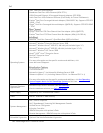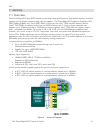Dell
Dell PowerEdge M910 Technical Guide 17
5.3 Thermal
The M910 thermal solution includes:
Optimized airflow impedance for individual blade and chassis level airflow balancing
Custom air baffling directs airflow through the components to maintain proper cooling
Custom-designed heat sinks maintain CPU, IOH, and Intel 7500 chip temperatures within
thermal design targets
Highly Optimized Fan Control Algorithm such as the following:
o Base fan speeds are a function of hardware configuration and ambient temperature
to minimize airflow for a given environment
o PID control algorithms are used for both CPU and DIMMs to maintain appropriate
thermal margin
o Double refresh switching allows for DIMM temperature excursions up to 95°C while
maintaining performance and thermal design targets as follows:
The M910 thermal algorithm monitors the thermal sensor on each DIMM to
maintain DIMM temperatures below the typical 85°C specification in normal
operating conditions.
Under extreme operating conditions, the thermal algorithm can switch the
DIMMs into Double Refresh mode allowing an additional 10°C of thermal
headroom. In Double Refresh mode, DIMMs are allowed to operate as high
as 95°C.
5.4 Power Efficiency
One of the main features of blade servers is enhanced power efficiency. The PowerEdge M910
achieves higher power efficiency by implementing the following features:
• User-configurable power options via the M1000e Chassis Management Controller (CMC)
• Improved power budgeting
• Voltage Regulator efficiency improvements
• CPU VR dynamic phase shedding
• Switching regulators instead of linear regulators
• Closed loop thermal throttling
• Use of DDR3 memory (lower voltage compared to DDR2)
• Memory VR static phase shedding
• BIOS Power/Performance options page
• Active Power Controller (BIOS-based CPU P-state manager)
• Ability to throttle memory
• Ability to disable a CPU core
• Ability to turn off embedded NICs or PCIe lanes when not being used
• Energy Smart components at the M1000e chassis level to selectively enable more computing
performance with less power consumption


















